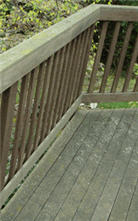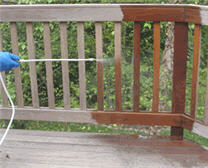Cleaning Deck Mold and Mildew - Removal

The horizontal surfaces of a deck are a prime spot for mold and mildew to start, and grow on your deck.
On some decks it thrives, favoring moist climates.
These fungi are caused by airborne spores that are carried by even a slight breeze. Where there is mold on the deck,
it will likely be on the limbs and branches nearby. Lichen too.
Exposed deck surfaces rather than the undersides are easier to remedy. Solutions involve eliminating
the unwanted or excess moisture and restoring circulation around the wood.
Important: Handling bleach can be harmful to the body, as with deck cleaners, so always wear protective gloves and
goggles. A breathing apparatus might be required. Although standard bleach is commonly used in killing algea/mildew and the like,
growing in popularity is the choice of
biodegrable oxygenated bleach cleaner and it is generally safer to the wood
and the environment.
Also, if you have composite decking be sure to check with your specific manufacturers' cleaning recommendations per their product.

1) Push broom or blow away the loose surface debris from the wood deck surface.
2) Clean the gaps between floor planks which will help with air circulation to keep the wood dry. Run a five-in-one tool
for wider joint gaps, and a thinner putty knife for the thinner ones. If left to stay, the packed organic
debris such as from leaves, pine needles and small twigs will condense and accumulate and this will then block drying,
holding damaging-causing moisture into the wood that can lead to rot and decay and biological growth.
3) Wet down the surrounding areas and plants, while avoid wetting the deck. Cover plants with vented plastic
(needed more when applying standard bleach than oxygenated).
4) Load a pump sprayer, be it a garden sprayer or an actual deck sprayer model (if using a oxygen bleach cleaner, pour the mixed solution through
a paint strainer to capture any undissolved grains). Apply an equal concentration
to all areas, in order to end with a consistent look. Some sealer manufacturers talk of a more mild 3 part-to-one rather
than a 2 part-to-one standard bleach dilution, to kill the spores. But this will depend on your particular situation and wood type.
However it is critical to kill the spores to prevent any mildew from coming back, even if it is to be treated with a sealer.
Also, putting on straight and stronger solutions of standard bleach does run the chances of drying the wood severely.

Consider sponging on the solution by the exterior wall and any bordering surfaces to try and contain it.
5) Let soak, and give a scrubbing with a brush to agitate, particularly on and around heavier builds of growth.
6) Rinse thoroughly with water and dilute around plants and trees (more so with standard bleach than oxygenated).
Repeat the application if trouble spots remain.
To prevent future growth
(a) increase the circulation both above and below the deck,
which can entail removing any lower walls or lattice, and
(b) look at having the nearby trees limbed, if they are the source of the fungi.
Check also for the mildewcide content in the sealer that is to be applied, again consulting the maker to see if
it can be added albeit with some added tint coloration.
Important: some sealers are formulated with mildewcide and this helps, given a clean starting surface, but keep in mind that sealers stored over a
period of years will loose their mildewcide value. If you have sealer that has been stored, consult the manufacturer for the
chances of adding the packet(s).

 The horizontal surfaces of a deck are a prime spot for mold and mildew to start, and grow on your deck.
On some decks it thrives, favoring moist climates.
The horizontal surfaces of a deck are a prime spot for mold and mildew to start, and grow on your deck.
On some decks it thrives, favoring moist climates.
 1) Push broom or blow away the loose surface debris from the wood deck surface.
1) Push broom or blow away the loose surface debris from the wood deck surface.
 Consider sponging on the solution by the exterior wall and any bordering surfaces to try and contain it.
Consider sponging on the solution by the exterior wall and any bordering surfaces to try and contain it.